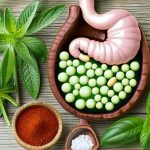Nausea and bloating are incredibly common digestive complaints, impacting people of all ages and backgrounds. They can range from mildly uncomfortable to severely debilitating, disrupting daily life and causing significant distress. While many over-the-counter medications exist to address these symptoms, an increasing number of individuals are turning towards natural remedies, specifically herbal treatments, as a gentler and often more holistic approach to relief. This shift reflects a broader trend toward preventative healthcare and a desire for solutions that work with the body rather than simply masking symptoms. Understanding how herbs like ginger, peppermint, and chamomile can offer support during times of digestive upset is empowering, allowing individuals to proactively manage their well-being and explore alternatives to conventional treatments.
The appeal of herbal remedies isn’t just about avoiding potential side effects associated with pharmaceuticals; it’s also rooted in centuries of traditional use. Many cultures have long incorporated these plants into their healing practices, recognizing their inherent properties and ability to restore balance within the body. It’s important to approach herbal medicine with respect and informed awareness – understanding that while generally considered safe for most people, interactions with existing medications or underlying health conditions are possible. This article will delve into the mechanisms behind how these three herbs work, practical ways to incorporate them into your routine, and crucial considerations for safe usage, focusing on providing helpful information rather than prescriptive advice.
The Power of Ginger: A Digestive Dynamo
Ginger (Zingiber officinale) has a long-standing reputation as one of the most effective natural remedies for nausea, particularly that associated with motion sickness or morning sickness during pregnancy. Its efficacy stems from compounds called gingerols, which have demonstrated anti-inflammatory and antioxidant properties. These gingerols work by influencing the digestive system in several ways – speeding up gastric emptying (the rate at which food moves from the stomach to the small intestine), reducing intestinal spasms, and even potentially blocking serotonin receptors that can trigger nausea. This multi-faceted approach explains why it’s so often recommended for a variety of causes.
Beyond simply alleviating nausea, ginger also plays a role in easing bloating and discomfort. Its carminative properties – meaning it helps to expel gas from the digestive tract – contribute to reducing feelings of fullness and pressure. Many people find that consuming ginger after a meal can prevent post-meal bloat or alleviate symptoms of indigestion. The warming nature of ginger is also thought to stimulate digestion, further aiding in the breakdown of food and preventing stagnation within the gut. This makes it a valuable ally for those prone to sluggish digestion or experiencing occasional digestive upset.
There are numerous ways to incorporate ginger into your routine. Fresh ginger root can be grated into tea, added to stir-fries, or even chewed directly (though its pungent flavor isn’t for everyone!). Ginger capsules are readily available, offering a convenient and standardized dose. Crystallized ginger provides a sweet treat with digestive benefits, but should be consumed in moderation due to its sugar content. Ginger ale can offer some relief, but many commercial varieties contain minimal actual ginger and substantial amounts of sugar – opting for naturally brewed options is preferable. If you are unsure about the underlying causes, consider tests that match symptoms.
Chamomile’s Calming Touch: Soothing the Digestive System
Chamomile (Matricaria chamomilla) is widely known for its calming effects on the nervous system, often used to promote relaxation and sleep. However, its benefits extend far beyond emotional well-being; it also possesses significant properties that can soothe digestive discomfort, including nausea and bloating. The key lies in chamomile’s anti-inflammatory and antispasmodic qualities – meaning it helps reduce inflammation in the gut and relax the muscles of the digestive tract. This relaxation is particularly helpful for individuals experiencing bloating caused by gas or intestinal spasms.
Chamomile works by calming the entire digestive process, reducing muscle tension that can contribute to cramping and discomfort. It’s believed to help regulate stomach acid production, potentially preventing heartburn and indigestion which often accompany nausea and bloating. Furthermore, chamomile contains compounds that may promote healthy digestion and reduce inflammation in the gut lining. This gentle approach makes it a particularly suitable option for individuals with sensitive digestive systems or those prone to irritation.
The most common way to enjoy chamomile’s benefits is through tea. Using high-quality loose leaf chamomile flowers often yields a more potent and flavorful brew than teabags. Chamomile can also be found in some herbal tinctures or capsules, providing concentrated doses for specific needs. It’s crucial to note that while generally safe, individuals with allergies to ragweed, chrysanthemums, marigolds, or daisies may experience an allergic reaction to chamomile. For more sustained support, explore herbal support options.
Peppermint’s Refreshing Relief: Unwinding the Gut
Peppermint (Mentha × piperita) is a refreshing herb widely recognized for its ability to alleviate digestive symptoms, particularly bloating and nausea. The active ingredient responsible for many of these benefits is menthol, which acts as a natural antispasmodic – meaning it helps relax the muscles in the gastrointestinal tract, reducing cramping and promoting smoother digestion. This muscle relaxation can be incredibly helpful for individuals experiencing irritable bowel syndrome (IBS) or functional dyspepsia, conditions often characterized by bloating, gas, and abdominal pain.
Peppermint’s cooling sensation also plays a role in soothing nausea. It influences nerve receptors involved in the vomiting reflex, potentially reducing feelings of sickness. It’s important to note that while peppermint is effective for many, it can worsen symptoms in individuals with gastroesophageal reflux disease (GERD), as it may relax the lower esophageal sphincter and allow stomach acid to flow back into the esophagus. Therefore, careful consideration of individual health conditions is crucial before using peppermint.
Peppermint tea is a popular choice, offering a soothing and flavorful way to experience its benefits. Peppermint oil capsules – specifically those formulated for enteric coating to prevent heartburn – are often used for IBS relief under professional guidance. Fresh peppermint leaves can be added to salads or infused in water for a refreshing digestive aid. However, consuming large amounts of peppermint may interfere with certain medications; it’s essential to consult with healthcare provider if you’re taking any prescriptions. To address related gut issues, consider exploring gut biome diversity. You may also benefit from herbal teas for gas relief.
In conclusion, harnessing the power of these herbal remedies – ginger, chamomile, and peppermint – offers a gentle yet effective approach to managing nausea and bloating. Remember that individual responses can vary, and what works best for one person may not work for another. Prioritizing a holistic lifestyle that includes a balanced diet, adequate hydration, stress management, and mindful eating habits will further support optimal digestive health. Always consult with a healthcare professional before starting any new herbal regimen, particularly if you have underlying health conditions or are taking medications. Many find relief through natural remedies and even morning light and gentle movement. Finally, don’t forget to address bloating during menstruation if applicable.


















